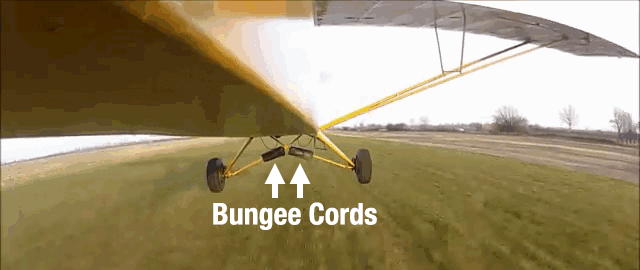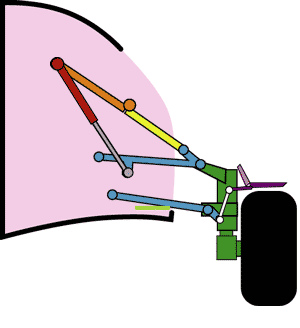
How the Landing Gear Works
Landing gear has a very hard, important, and critical job. It has to support an enormous amount of weight. Some aircraft land at at as much as 170 knots. The maximum impact for a good landing is 2.6 G. That's 2.6 times the amount of force as the weight of the airplane. Since landing gear also needs to be shock absorbent, struts have the job of minimizing the impact. Struts are the connection between the fuselage and the landing gear. There are four types of struts; rigid struts, spring steel struts, bungee cords, and most commonly used, shock struts. Rigid struts were the first type of struts on aircraft. Rigid struts are directly attached to the frame of the plane, not the fuselage. (See Fuselage) By doing this, the shock is spread out through the whole plane, not only on one spot.
Spring steel struts are just a strip of metal connected on a slant. The bottom to the landing gear, and on the top to the fuselage.
Bungee cord struts are two bungee cords in between the landing gear which is very close together, and the fuselage. When the landing gear tries moving apart from the weight of the aircraft, it pulls on the bungee cords instead of ripping the airplane apart.
Oleo struts are the type of struts used mainly on big and heavy airplanes. They are the most effective for big planes.
The cylinder is filled half with hydraulic fluid, and half with nitrogen. When the piston moves up from impact, the hydraulic fluid gets pushed up through the orifice. The pressure from the landing pushes up the hydraulic fluid very fast through the small hole. That creates a lot of heat. In the process, the impact is converted into heat, thus lessening the amount of force felt onboard.
Having big wheels connected to sticks hanging out of an airplane makes the airplane less aerodynamic thus making it significantly slower. Have you ever noticed that when you see a large airplane in flight, you cannot see it's landing gear? Then when it lands, you see the landing gear. That is because that airplane has retractable or semi-retractable landing gear. Retractable landing gear is when the landing gear is fully tucked in a compartment inside the aircraft and a "door" fully covers it.
Semi-retractable landing gear is when instead of the landing gear going all the way into the compartment and the compartment closes, the landing gear retracts until it is flush against the outside of the aircraft.
In the cockpit, when the pilot flips the switch to make the landing gear go down or up, it triggers a whole system, which is usually hydraulic. This is a brief explanation of how it works:
Number one is a hydraulic piston. When it pushes out, it pushes the "triangle" back and up. By doing so, it pushes the landing gear up. Other airplanes have their landing gear pulled up and down in different ways.
When most people think of landing gear, they think of three sets of wheels; one in the front, and two in the back. Not only do some airplanes have different arrangements of wheels, but some don't have wheels at all. Landing gear is anything that supports an aircraft on the ground.
Most airplanes have wheels, but some have pontoons to go on water,
some have skis to go on ice and snow,
and some have skids, which are similar to skis to land quickly on deserts or snow.
Some even have a combination of landing gear, like pontoons and wheels so they can take of on land and land in the water or vice versa.
Those are the four main categories of landing gear, but there are also subcategories. For instance, most airplanes that have wheels, have tricycle wheels.
Tricycle wheels are when there is one set of wheels in the front and two in the back. Depending on the size of the aircraft, one set of wheels can have up to eight wheels on them.
There are also conventional and tandem landing gear arrangements. Conventional landing gear was a very popular arrangement on early airplanes. Nowadays, it is mostly used on small airplanes. Conventional landing gear is the opposite of tricycle landing rear. Instead of two sets of wheels on the back and one on the front, there are two sets of wheels on the front and one on the very back on the tail.
Tandem landing gear is mostly used on big airplanes like the B-52 bomber and the U-2 reconnaissance/research aircraft. Tandem landing gear arrangement is when there are a couple sets of wheels arranged one after the other in a straight line along the fuselage.
Tandem landing gear is not commonly used. The airplanes that do use it usually have a very large wingspan so they need a small wing at the tip to help them balance.















